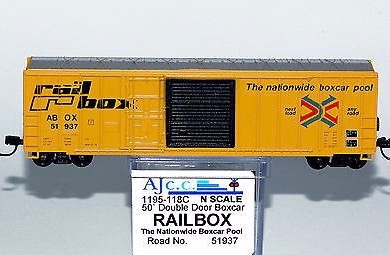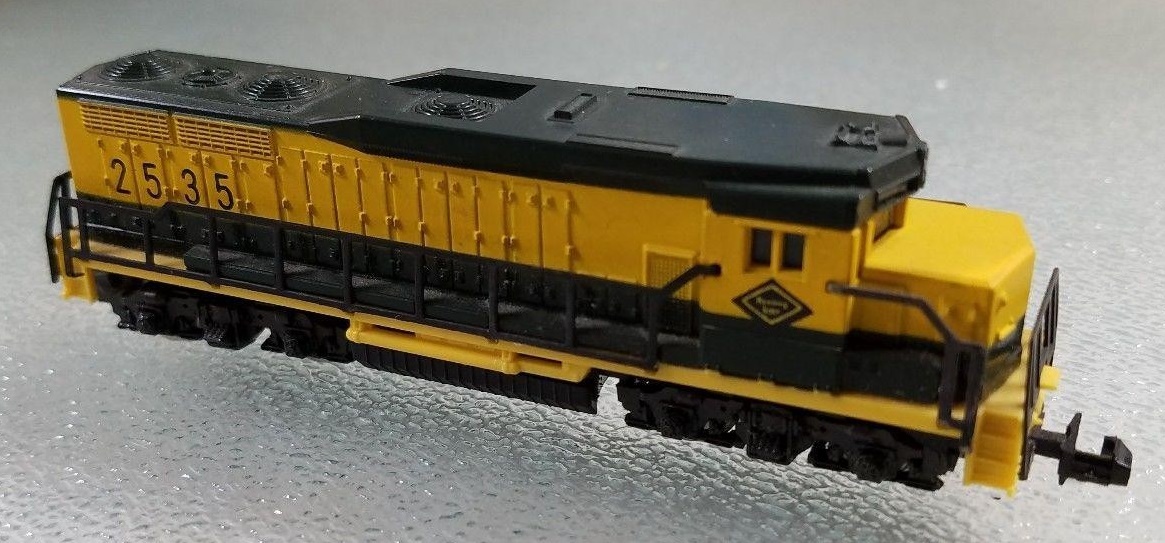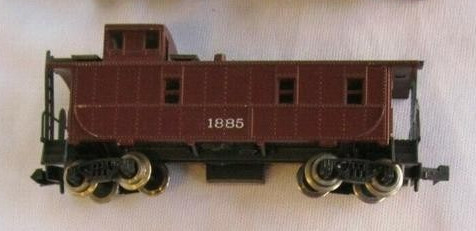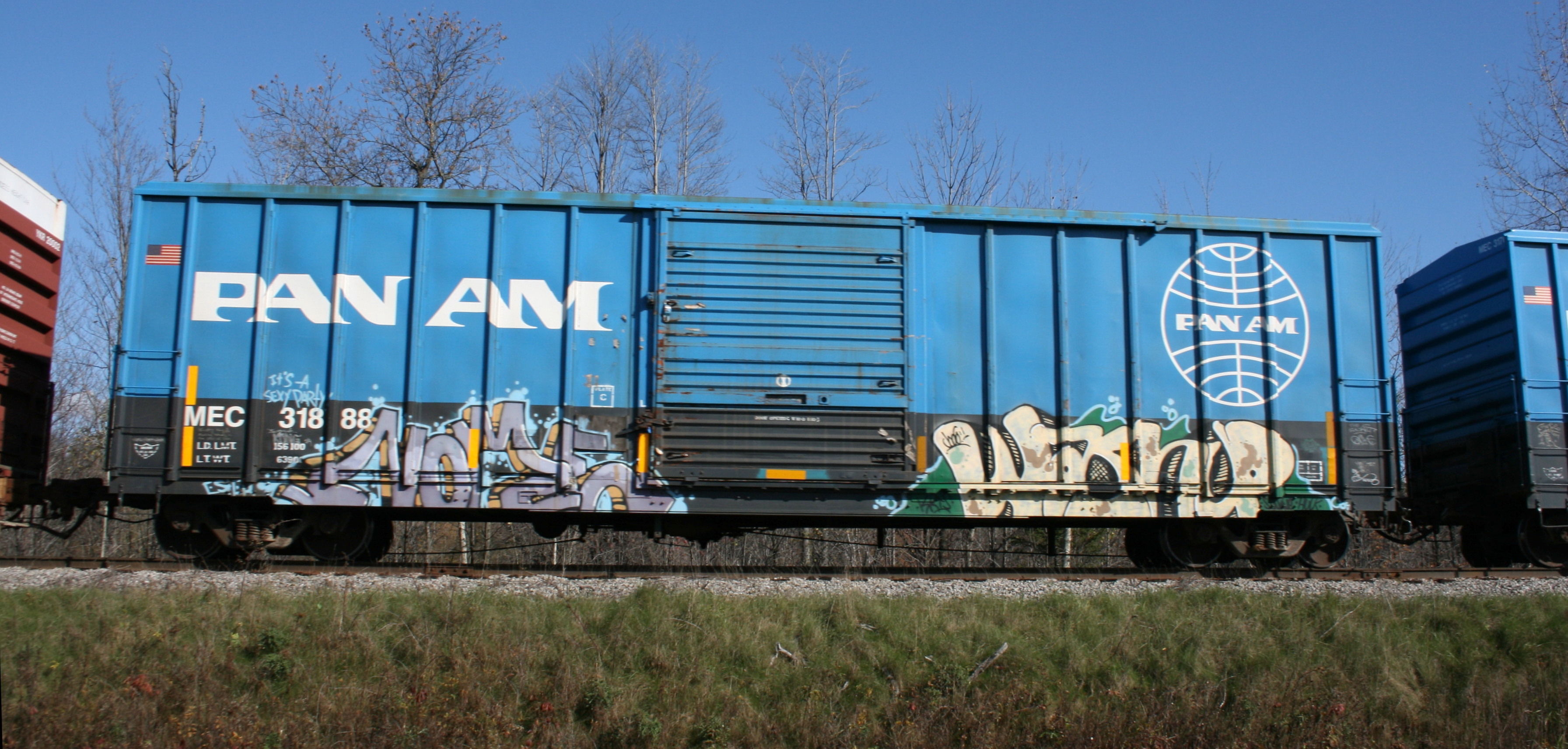Model Information: Single Sliding Door Rib Side Without Roofwalk FMC. Originally designed by MDC Roundhouse. This tooling was acquired by Athearn in June of 2004 and re-released under the Athearn name. The MDC releases referred to this tooling as "FMC 50 Foot Boxcar - Single Door". Athearn refers to them as "FMC 5347 Box Car(sic)", but they are the same model.
The MDC Roundhouse releases typically came as kits (though some later releases were RTR) with an unpainted pewter underframe and truck-mounted couplers and blackened low-profile metal wheels. The Athearn releases have a nicer set of wheels (also low-profile). The Athearn models are always Ready-to-Run (RTR). The Athearn models have painted (black) underframes that are also metal (likely pewter or whatever MDC used). Athearn moved the couplers to become body-mounted and changed the coupling system from Rapido to McHenry. After inspecting them closely, I am not sure they can be swapped for MTL couplers without filing off part of the underframe, but I could be wrong. This presents a problem as McHenry couplers don't always play well with other couplers on long consists where that is a lot of force on each coupling point. The body has remained unchanged with the only detail part being the brake wheel.
The newer releases of this body style (as of 2017) market this boxcar as specifically modelling the FMC 5347 prototype.
The MDC Roundhouse releases typically came as kits (though some later releases were RTR) with an unpainted pewter underframe and truck-mounted couplers and blackened low-profile metal wheels. The Athearn releases have a nicer set of wheels (also low-profile). The Athearn models are always Ready-to-Run (RTR). The Athearn models have painted (black) underframes that are also metal (likely pewter or whatever MDC used). Athearn moved the couplers to become body-mounted and changed the coupling system from Rapido to McHenry. After inspecting them closely, I am not sure they can be swapped for MTL couplers without filing off part of the underframe, but I could be wrong. This presents a problem as McHenry couplers don't always play well with other couplers on long consists where that is a lot of force on each coupling point. The body has remained unchanged with the only detail part being the brake wheel.
The newer releases of this body style (as of 2017) market this boxcar as specifically modelling the FMC 5347 prototype.
Prototype History: It was the mid 1970s, and the incentive per diem box car boom was just beginning. New, brightly painted box cars seemed to appear overnight. Many were lettered for various short lines. FMC (Food Machinery Corporation) was a significant builder of many of these cars. The 50’ outside post, non-terminating end box car, became the foundation for new per diem cars built in the 1970s. The 50’ FMC cars also varied in door configuration and style to better suit each customer. These cars can still be seen today at work (2017) on many ralroads.
The main difference between the 5077 cu. ft cars built by FMC vs the 5277-5347 cu. ft cars built by the same manufacturers is the overall height of the car, the smaller 5077 cars were Plate B while the larger 5277-5347 cars were Plate C.
The main difference between the 5077 cu. ft cars built by FMC vs the 5277-5347 cu. ft cars built by the same manufacturers is the overall height of the car, the smaller 5077 cars were Plate B while the larger 5277-5347 cars were Plate C.
Road Name History:  The Providence and Worcester Railroad (reporting mark PW) (NASDAQ: PWX) is a Class II railroad in the United States. The railroad connects from Gardner in central Massachusetts, south through its namesake cities of Worcester and Providence, Rhode Island, and west from Rhode Island through Connecticut and into New York City. The railroad's connection between New Haven, Connecticut and New York City and onto Long Island is via trackage rights over the Hell Gate Bridge.
The Providence and Worcester Railroad (reporting mark PW) (NASDAQ: PWX) is a Class II railroad in the United States. The railroad connects from Gardner in central Massachusetts, south through its namesake cities of Worcester and Providence, Rhode Island, and west from Rhode Island through Connecticut and into New York City. The railroad's connection between New Haven, Connecticut and New York City and onto Long Island is via trackage rights over the Hell Gate Bridge.
The P&W was incorporated in Massachusetts as the Providence and Worcester Railway on March 12, 1844, and as the Providence and Worcester Railroad in Rhode Island in May 1844. The two companies were merged November 25, 1845 as the Providence and Worcester Railroad. The company bought the Blackstone Canal, also running between Providence and Worcester, and began construction, partly on its banks, in 1845. The line opened in two sections, the part south of Millville on September 27, 1847, and the rest on October 20. The line from Providence to Central Falls was shared with the Boston and Providence Railroad, which at the same time built a connection from its old line (ending in East Providence) over to the P&W.
On July 1, 1892, the New York, New Haven and Hartford Railroad leased the P&W for 99 years. The New Haven merged into Penn Central on January 1, 1969. On April 6, 1970, the P&W announced its intention to separate from the merger. After a legal battle, the Interstate Commerce Commission approved the request on August 25, 1972, and, on November 2, Penn Central signed the agreement, effective December 30. The P&W cancelled the lease on February 3, 1973. Since then, the P&W has taken over many other lines from the former Penn Central in addition to several from the Boston and Maine Railroad. On March 17, 2013, a freight derailed in New Haven, Connecticut, blocking Amtrak's Northeast Corridor.

The P&W was incorporated in Massachusetts as the Providence and Worcester Railway on March 12, 1844, and as the Providence and Worcester Railroad in Rhode Island in May 1844. The two companies were merged November 25, 1845 as the Providence and Worcester Railroad. The company bought the Blackstone Canal, also running between Providence and Worcester, and began construction, partly on its banks, in 1845. The line opened in two sections, the part south of Millville on September 27, 1847, and the rest on October 20. The line from Providence to Central Falls was shared with the Boston and Providence Railroad, which at the same time built a connection from its old line (ending in East Providence) over to the P&W.
On July 1, 1892, the New York, New Haven and Hartford Railroad leased the P&W for 99 years. The New Haven merged into Penn Central on January 1, 1969. On April 6, 1970, the P&W announced its intention to separate from the merger. After a legal battle, the Interstate Commerce Commission approved the request on August 25, 1972, and, on November 2, Penn Central signed the agreement, effective December 30. The P&W cancelled the lease on February 3, 1973. Since then, the P&W has taken over many other lines from the former Penn Central in addition to several from the Boston and Maine Railroad. On March 17, 2013, a freight derailed in New Haven, Connecticut, blocking Amtrak's Northeast Corridor.
Item created by: CNW400 on 2020-08-29 22:02:32. Last edited by CNW400 on 2020-08-29 22:02:33
If you see errors or missing data in this entry, please feel free to log in and edit it. Anyone with a Gmail account can log in instantly.
If you see errors or missing data in this entry, please feel free to log in and edit it. Anyone with a Gmail account can log in instantly.









